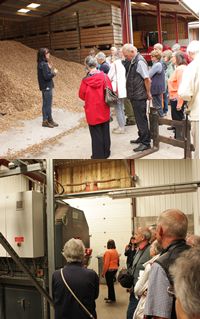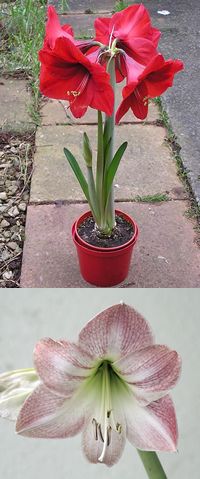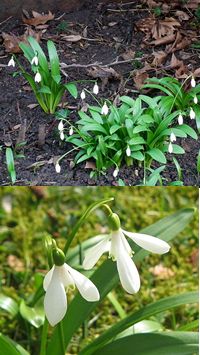2015 proved a very successful year for the Group. Starting with Professor Sir Ghillean Prance describing the fascinating plant- insect interactions he came across in the Amazon forests through visits to a mixture of commercial and amenity nurseries. These included topics like, propagating trees on the top of Exmoor, honeysuckle as a new fruit crop and the subject of the article below, growing crops for gas production.
2016 will start as usual with the PHGSW Cannington Conference. This years conference is being held on 11 February and is entitled 'Growing Media'.
2015 also saw important changes to the Group Committee with biocontrol specialist Tony Girard taking over as Chairman and former David Miller Award winner Sebastian Eves-van den Akker, Professor Paul Hadley and Professor David Atkinson adding to the strength and breadth of the Committee.
Peter Grimbly
Contents
From Growing Crops to Growing Fuel
Plant of the Month and Medicinal Plant of the Month
News from our Associates
Horticulture Industry News
Events Calendar
Horticulture Group contact details
Related Links
From Growing Crops to Growing Fuel

Initially the farm, run by Nick and Claire Bragg concentrated on potatoes and this remained the cornerstone of the farm until market conditions finally forced them to cease growing this crop in 2015. How then to make their farm pay. Nick and Claire have always welcomed visitors to the farm and, believing they should learn about the crops from ‘food to fork,’ this has expanded into offering courses on a wide variety of cooking skills. One of their barns has now been converted to enable them to run a regular series of cookery courses.

The latest change to the farm and perhaps the main reason for our visit was the installation of a large anaerobic digester. This came about by chance rather than design. The farm lies alongside the A303 and more importantly a main high pressure gas pipeline, part of the gas grid distributing gas around the country. The farm is thus in an excellent location for the digester to supply gas direct into the grid. Furthermore, since the digester needs feeding with biomass, the 800 acres of arable fields now no longer being used for potatoes are growing grass, cereals and maize to help feed this digester which will produce biogas to be pumped into the national gas grid. The digester is being built by a separate company, Sustainable Energy Generation Limited, and once fully operational will produce up to one Million Watts of energy when required.
Once the mixture fed into the digester has completely fermented, the residue can be recycled on to the land to both improve soil structure and fertilise the following crops. To this can be added the waste from the chicken houses further reducing the farms requirements for outside inputs.
While much of the farm lies on higher land it does incorporate a valley which has been used to create a wildlife habitat with ponds and woodland. Thus the many visitors attracted to the farm see not only a working arable farm with a mixture of crops but also some country stewardship.
Plant of the Month
Hippeastrum hybrids, amaryllis, Amaryllidaceae
This month’s plant is a common gift at Christmas in the form of a dormant bulb in a box. Commonly known to many as an amaryllis – this bulb is botanically known as Hippeastrum. There has been much discussion and dispute over the correct name for this genus of plants. Originally named amaryllis, for the type species Amaryllis belladonna, a South African bulb, further species discovered in South America were added into the same genus. Eventually, a proposal was made to split the South American species away into their own genus. William Herbert had initially proposed the generic name Leopoldia in 1819 but then in 1821 he proposed Hippeastrum stating “I have named them Hippeastrum or Knights Star Lily pursuing the idea which gave rise to the name equestris”, purportedly referring to the species Amaryllis equestre. An enigmatic statement that leaves us slightly mystified to this day. The greek word Hippeus does however mean rider or mounted knight and Astron means star.

The centre of diversity in South America for this genus is Eastern Brazil. The cultivated hybrids, such as the examples pictured right by Arpingstone and Th.Voekler, and are of complex parentage but the contributing species may include H. aulicum, H. elegans, H. puniceum and H. striatum. The breeding of these hybrids was started by a watchmaker in 1799 working in the north of England. Today, breeding these bulbs is big business and takes place across the world, from the USA, to Holland, India and many more countries.
On receiving a dormant bulb, it should be planted in good all-purpose compost (or John Innes No 2) in a pot only a little larger in circumference than the bulb. One third of the bulb should be left above the compost level and the pot placed in a warm and light place. Water sparingly until the bulb comes into growth. Continue to water and feed regularly as the flower stem emerges at a rate of several inches a day eventually to reveal a flower head of 2 to many large trumpet shaped flowers. Moving the pot to a cooler place when in flower will prolong the flowering period. Once the flower has finished the leaves will persist for many months. It is crucial to keep feeding this plant and watering right through until September time. A summer holiday outside will do no harm as long as the plant is not in the full sun. In September it is time to encourage the bulb back into dormancy or semi-dormancy but reducing or stopping altogether the watering, and moving to a cooler, darker spot, allowing the leaves to die back. The bulb should be rested for 8 to 10 weeks before top-dressing or re-potting the bulb, bringing into a warmer and lighter spot and commencing gentle watering until the bulb starts to show signs of growth again. If treated well, the bulb should re-flower for many years.
Alison Foster
Royal Botanic Gardens Kew
Medicinal Plant of the Month
Galanthus woronowii, snowdrop, Amaryllidaceae
Although January may not normally be the main month of the snowdrop season, 2016 is looking set to be well ahead of the norm in terms of flowering times. As the year starts, many people are reporting plants in flower that they would normally expect to see several weeks into the future.
My garden is no exception. Already the winter aconites (Eranthis hyemalis) are in full flower and many different kinds of snowdrops are starting to flower, this species amongst them.
Rather than the narrow glaucous leaves of the common snowdrop (Galanthus nivalis), this Caucasian species has bright shiny green, wide leaves underneath the nodding white flowers. These shiny green leaves emerge with one leaf tightly clasped around the other. This is described by botanists as supervolute vernation. Which kind of vernation a snowdrop exhibits assists in the identification of the particular kind. There are two other main kinds of vernation applicable here: applanate – where the emerging leaves are pressed flat to each other – and explicative – where the leaves are pressed flat to each other but the edges are folded or rolled back.

All snowdrops are listed on the CITES (Convention on the International Trade of Endangered Species) Appendix II list. This is a list of currently non-threatened species that nevertheless should have their trade monitored and regulated. In fact, this species has been the subject of a collaborative project between Royal Botanic Gardens, Kew and Microsoft Ecology to survey populations of this species and to model potentially sustainable levels of annual harvest in Georgia. Georgia harvests in the region of 15 million bulbs of this species alone for use in the horticulture trade. Furthermore, the Kew and Microsoft project aims to develop management and monitoring systems to ensure the harvest remains at a sustainable level, not endangering this species future in the wild.
Galanthus woronowii was the first snowdrop that the medicinally extremely useful substance galanthamine was isolated from. Galanthamine is currently recommended for the treatment of moderate Alzheimer’s disease by the National Institute of Health and Clinical Excellence (NICE) but is very effective in earlier stages of the disease too. Although originally isolated from this snowdrop, galanthamine can be found in many other members of the Amaryllidaceae such as Narcissus spp., Leucojum aestivum and Crinum amabile. Today, part of the commercial supply of this molecule comes from chemical synthesis, itself an amazing chemical achievement due to the structural complexity of the molecule, and partly from the natural product isolated from different sources across the globe. In China, Lycoris radiata is grown as a crop, in Bulgaria, Leucojum aestivum is farmed and in the UK the humble daffodil, Narcissus ‘Carlton’ is the provider. The estimated patient population for Alzheimer’s is 5.2 million and the predictions are that galanthamine will be used to treat almost half a million of those sufferers. Sales of Reminyl (galanthamine) in 2003 were £7.9M. One hectare would provide between 15 and 20 tons of bulbs and several hundred tons of bulbs would be required per year to supply all the galanthamine required.
News from our Associates

Following a successful first time presence in 2014, CHA will again be organising UK pavilions and a high-profile British participation at the biennial GreenTech Amsterdam, at RAI Amsterdam in June 2016 (14-16 June). GreenTech is the international horticultural exhibition with a clear focus on technology and innovation, specifically concentrating on new developments in cultivation and the ‘beginning of the chain’. Taking place every two years at RAI Amsterdam, and filling the void left by the demise of HortiFair in 2012, GreenTech has been created in close co-operation with the industry, sector organisations and market leaders to deliver a highly relevant event for the international horticultural industry. The visitor target group is clearly identified as international growers and breeders, with the event providing access to everything they need to grow and optimise their production. Additionally an extensive seminar programme will introduce latest innovations and horticulture technology and knowledge. The event offers an exciting opportunity for both new and experienced British exporters to present the latest product developments, services and innovations to key international growers and investors derived from vegetable, floriculture, glass and open field horticulture. Anyone interested in exhibiting should contact CHA.

Sadly the UK Plant Science Federation has failed to attract sufficient funding to sustain it at the level it has managed to maintain for the last three years. It has recently been fully absorbed into the Royal Society of Biology as a Special Interest Group.
Horticulture Industry News
For the very latest horticultural news follow us on Facebook,
Twitter, or
LinkedIn
A healthy diet for Aphids
Aphids suck up an almost endless supply of sugary sap from their plant hosts. They can survive on this junk food diet because bacterial partners help them convert the handful of amino acids in the sap into other, essential amino acids—not by recycling them, but by breaking them down and rebuilding from scratch, a new study finds. By following the fate of carbon and nitrogen atoms ingested by the aphids scientists found that amino acid synthesis takes a very indirect route. Plant sap predominantly contains four amino acids—glutamine, glutamate, asparagine and aspartate—which serve as the primary nitrogen source for the aphid. Plant roots synthesize these amino acids to transport nitrogen compounds, which they take up from the soil. To keep from starving, aphids have evolved a symbiotic relationship with a bacterium called Buchnera aphidicola, which helps to provide essential amino acids. Buchnera is an endosymbiont that can no longer survive independently outside of the aphid. The researchers fed pea aphids (Acyrthosiphon pisum) a diet of sugar sap and amino acids containing heavier isotopes of carbon or nitrogen. Once the aphids had incorporated the isotope-labelled amino acids into their bodies they saw that the amino acids inside the aphid’s cells were a mixture of heavy and light atoms, indicating that the plant amino acids had been completely dismantled and remade. Even aspartic acid, which the researchers supplied in bulk to the aphids, was broken down and resynthesized.
A tasteless antimicrobial
Scientists have found a way that the antimicrobial properties of the spice turmeric (Curcuma longa) might be employed without making foods taste like turmeric. They discovered how to coat glass and metal with curcumin — the main antibacterial chemical in turmeric. The curcumin is embedded in nano-capsules, so it doesn’t rub off and flavour foods. You could imagine using this technology to coat the insides of cans or knives and countertops — to provide a new line of defense against food-borne illness. They also thinks this technology could be used to make fresh produce safer.
Endophytic bacteria promote Growth in Okra
A study made of the response of three endophytic bacterial strains from the leaves of Okra, Abelmoschus esculentus, and Andrographis paniculata (king of bitters or Indian echinacea) in the presence of okra root exudates. All readily formed biofilms, an initial step for successful endophytic colonization. The results demonstrated that these endophytic strains augmented plant biomass by greater than 40 %. Root and shoot lengths of okra plants increased up to 34 and 14.5 %, respectively. The endophytic isolates also exhibited significant in vitro antagonistic potential against the collar rot pathogen Sclerotium rolfsii.
Brown Mustard as a control for Sclerotinia
Current control methods of Sclerotinia sclerotiorum rely predominantly on the use of fungicides to kill the fungus’s ascospores. Biofumigant plants – mosty Brassica species - offer a possible alternative. Tests were made using dried and milled plant material from six different ‘biofumigant’ crop plants to determine effects on carpogenic germination of sclerotia and mycelial growth of S. sclerotiorum. All the biofumigant plants significantly reduced germination of S. sclerotiorum sclerotia in microcosm experiments, but were less effective against larger sclerotia. In vitro experiments showed a direct effect of biofumigant volatiles on both the mycelial growth of S. sclerotiorum, and carpogenic germination of sclerotia, where the most effective treatment was the Brown Mustard, Brassica juncea ‘Vittasso’.
Events Calendar
Other Events of Interest:
International Advances in Pesticide Application
13 - 15 Jan 2016, Association of Applied Biologists
Barcelona, Spain
Plant Ecophysiology
14 - 17 Jan 2016, Parque Katalapi
Parque Katalapi, Chile
Succulents and other Ornamentals
24 - 28 Jan 2016, International Society for Horticultural Science
Wayanad, India
The role of science in food and agriculture
27 Jan 2016, Westminster Forum Projects
London, UK
Genome Engineering and Synthetic Biology: Tools and Technologies
28 - 29 Jan 2016
Ghent, Belgium
Plant Volatiles
31 Jan 2016 - 5 Feb 2016, Gordon Research Conferences
Ventura, USA
Plant Genetics and Breeding Technologies
1 - 2 Feb 2016, VISCEA
Vienna, Austria
UK Grower Awards
3 Feb 2016, Horticulture Week
London, UK
Plant Model Species: Fundamentals and Applications
4 - 5 Feb 2016, VISCEA
Vienna Austria
Plants In Vitro: Theory and Practice
8 - 9 Feb 2016, VISCEA
Vienna, Austria
Plant Genes and "Omics": Technology Development
11 - 12 Feb 2016, VISCEA
Vienna, Austria
Tree and Plant Health Early Warning Systems in Europe
23 - 24 Feb 2016, Observatree
Kew, UK
Environmental Management & Crop Protection
23 - 24 Feb 2016, Association for Crop Protection in Northern Britain
Dundee, UK
Contested Agronomy: whose agronomy counts?
23 - 25 Feb 2016, Institute of Development Studies
Brighton, UK
Plant Resistance to Insects Symposium
5 - 8 Mar 2016
Stellenbosch, South Africa
Processing Tomato Congress
6 - 9 Mar 2016, International Society for Horticultural Science
Santiago, Chile
Tropical and Subtropical Ornamentals
7 - 9 Mar 2015, International Society for Horticultural Science
Krabi Province, Thailand
Plant Breeding Symposium: 'Back to the Phenotype'
8 - 10 Mar 2016, South African Plant Breeding Association
Stellenbosch, South Africa
In Vitro Culture and Horticultural Breeding
13 - 15 Mar 2015, International Society for Horticultural Science
Giza, Egypt
Sexual Plant Reproduction
18 - 23 Mar 2016
Tucson, USA
Horticulture Group Contact Details
For submitting ideas or to volunteer to be part of a committee or a group, please contact:
Chairman - Tony Girard
Meetings Coordinator - Peter Grimbly
Minutes Secretary - Margaret Waddy
Newsletter co-ordinator - Sue Grimbly scihortigroup@btinternet.com
